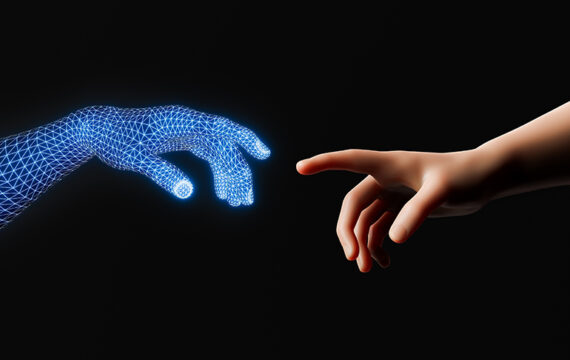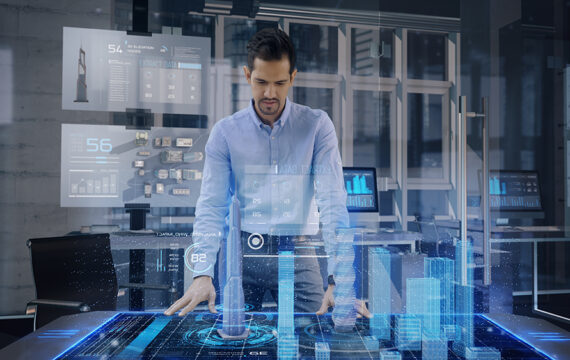While most construction costs are rather predictable, ongoing operations and maintenance costs are anything but. These costs fluctuate a lot based on occupancy rates, seasonality, and operating practices. Yet, pulling all relevant data points to get the big picture hasn’t always been easy.
Computerized maintenance management systems (CMMS), affordable sensors and IoT devices, connected cameras, and asset management software help managers make more sense of physical environments. However, these insights are fragmented, covering only certain operational processes and/or systems.
Digital twin (DT) technology emerged as a response to siloed visibility.
A digital twin is a virtual replica of a physical asset (such as a building) powered in real time from on-site sensors, cameras, and various business systems. Digital twin technology helps bring together compartmentalized data sets and systems to perform real-time facility monitoring, analysis, and optimizations.
But there are even more reasons why digital twins and facility management are a strong match.
6 facility management challenges to be solved with digital twins
The idea of using digital twins for facility management may sound new, though the AEC sector is no stranger to virtualizing physical assets. Building information modeling (BIM) has been in development since the 1970s and was finally documented as ISO Standard 19650 in January 2019.
BIM successfully replaced paper printouts created with computer-aided design (CAD) software, bringing more efficiency in the design and construction phases. However, BIM is less useful when it comes to digital facility management.
While BIM is a capable asset management (AM) tool it lacks the analytical capabilities and level of information richness for the complex situations and comprehensive data management required, especially during the operations and maintenance (OM) phase.
BIM and digital twins share a number of common principles. Both aim to improve process visibility, project planning, and asset management practices.
The key difference is that BIM models are static. They don’t account for the impacts of occupant behavior. 3D digital twins, in contrast, are living representations of the building. Unlike static BIM models, a digital twin of buildings has real-time information about space usage, occupancy rates, and asset operating conditions, among other parameters.
On the analytics side, a digital twin facility enables managers to conduct more precise evaluations, simulate future use, and implement predictive maintenance scenarios.
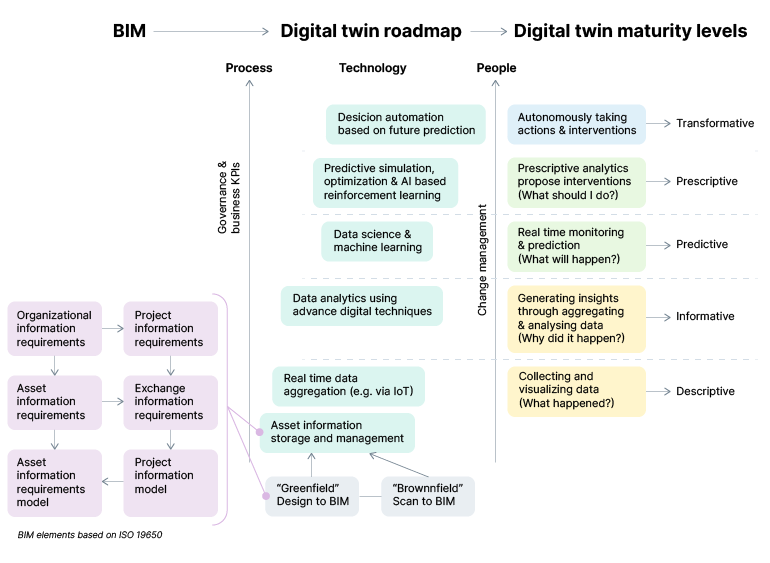
Source: building SMART International — Take BIM Processes to the next level with Digital Twins
By bringing real-time data into decision-making, digital twins help facility managers better deal with the following issues:
Fragmented data
The number of data sources in digital facility management systems has increased exponentially. Smart energy meters, new IoT-powered electrical systems, camera-based security monitoring, and workplace management systems — facility managers have a plethora of avenues for collecting data. It is difficult to operationalize that data, however.
A Toggled survey found that although 78% of facility decision-makers have deployed smart building features, over a third (38%) struggle to integrate the required data analytics into their smart building platforms. As a result, pervasive blind spots remain in costly areas such as energy use, asset servicing, and space utilization.
A digital twin in facility management helps establish a virtual connection between different physical and digital assets, bringing together compartmentalized data streams into one unified platform for real-time monitoring and analysis.
For example, a digital twin can include data from:
- Asset management software
- Computerized maintenance management systems (CMMS)
- Building automation systems (BAS)
- On-site cameras
- Any number of installed IoT devices
Using real-world data from cameras, sensors, and connected third-party systems, you can transform static BIM designs into detailed digital twin buildings.

Source: ResearchGate — Digital Twin: Vision, Benefits, Boundaries, and Creation for Buildings
Poor system interoperability
BIM was envisioned as a shared knowledge system for the AEC industry, but it didn’t live up to the promise. The lack of shared standards and software vendors’ reluctance to propose adopted frameworks to protect their market share has significantly limited users’ ability to
share information with other stakeholders and transfer it to proprietary systems.
The frustrating spectrum of BIM interoperability issues was best summed up by a Finnish construction industry professional who was asked about his experience after nationwide BIM implementation:
Having two separate systems talking to each other, it’s not that impossible. It’s 2015 and we went to the moon in the 60’s. So, how come we can’t get some sort of attribute from one system to another in 2015?
Interoperability remains a problem today. A 2020 study notes that most BIM systems are still poorly integrated with:
- AutoCAD files
- Energy management software
- IoT devices and sensors
- Cloud computing systems
- AR/VR technologies
A group of researchers attempted to integrate BIM into an AR mobile app for more convenient management for a healthcare facility in Atlanta, Georgia. However, they faced issues with converting AutoCAD data into a mobile-friendly format, which led to data loss and inconsistencies in object geometries.
In another case, researchers tried to import BIM files to perform energy simulation in popular analytics platforms like GBS, OpenStudio, and EnergyPlus. But they faced major issues including missing data, error transference, and poor data recognition.
Digital twin for facility management emerged as an opportunity for transformation. The technology can act as an extra connectivity tissue, aggregating and standardizing data from different sources in a shared virtual repository. By design, digital twins are built with more operability in mind, taking advantage of native cloud architecture and application programming interfaces (APIs).
The aggregated data can be used for a variety of data analytics scenarios. AI and ML models, in turn, can be used to enable predictive and prescriptive use cases.
Soaring operating costs
Commodity prices grew by double digits over the past year, accelerating inflation, which in turn triggered across-the-board price increases. In Europe, energy and gas prices reached all-time records, sharply cutting into profit margins.
In addition, facility managers faced double-digit cost increases for most services and supplies related to facility management.
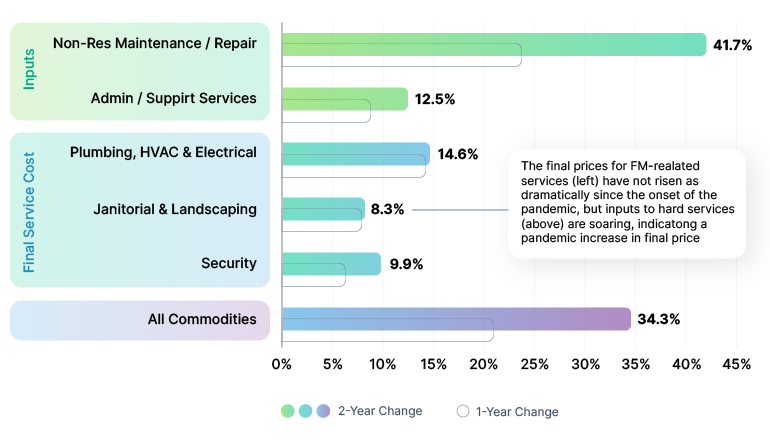
Source: CBRE — Facilities Management Cost Trends in 2022
With constant worries over further inflation and possible recession, facility managers now need to operate on leaner budgets. While digital twin development requires an initial investment, digital twin solutions help optimize costs in the long run.
Let’s take energy management as an example. Digital twins can consolidate all utility data and understand energy consumption rates under different occupancy scenarios. For example, you can automatically switch most systems to power-saving mode after the last tenant leaves the workplace or automatically adjust the temperature in unoccupied rooms. During a set of 10 pilots, a digital twin solution helped companies save an average of 40% on energy costs, 15% on facility management costs, and 30% on operating costs.
Sustainability concerns
The AEC industry has its fair share of environmental impact. In the UK, 30% of emissions come from buildings, with heating responsible for 23% of these. Facility managers, in particular, feel joint pressure from regulators, investors, and tenants to transition to sustainable operating practices.
A CBRE survey found that 80% of tenants cite personal values and ethics as the main driver for supporting their organization’s sustainability goals, whereas 40% of investors are driven by regulatory targets.
New regulatory frameworks like ASHRAE Standard 228 have emerged to promote a progressive transition to Zero Net Energy and Zero Net Carbon operations. The problem, however, is that many organizations lack the skills to perform initial benchmarking and establish realistic net-zero transition plans.
Digital twin platforms can help capture present-day data around carbon output, emission scopes from company-owned assets, or controlled sources of emissions such as electricity, gas, fuels, and vehicles to document the starting point. Digital twin sustainability in facility management can help locate opportunities for optimizing resource use, be it reducing energy consumption through optimized light management scenarios or reducing waste through the purchase of reusable supplies.
Moreover, by improving our understanding of how buildings work, we can create more energy-efficient and sustainable building designs. Intellias and CREE Buildings, for example, have partnered to create a digital platform for disseminating green building practices in the AEC industry and promoting the adoption of forward-thinking construction methods and digital twin building management systems.
Supply chain issues
Supply chain disruptions are a new operating constant. Prices on asset component lead times have grown by 30% to 50% since 2020. Frequent stock-outs and back-ordering further increase unplanned downtime. Almost 52% of facility managers surveyed by Jilt named parts and equipment shortages as their main concern in 2023.
There are pent-up supplier cost increases and delivery risks in the FM supply chain globally. Now is the time for a comprehensive review of FM procurement strategies, service levels, and delivery approach.
Digital twins can help facility managers switch from reactive to predictive maintenance. By having better visibility into the age of managed assets, service history, spare parts counts, and locations, managers can implement just-in-time procurement to avoid costly delays and timely servicing. This way you can not only extend asset life but also optimize maintenance schedules. Speaking of which…
Labor shortages
Maintenance, repair, janitorial, and engineering talent is in short supply. With fewer people on the market, facility managers face longer hiring cycles and increased salary budgets. According to Blumberg Advisory Group, low labor supply is also one of the driving factors for higher operating costs.
Outsourcing and subcontracting are the traditional routes for dealing with labor shortages, comprising 50% of the total facilities management market in several regions, including Europe, the Middle East, and North America.
Yet, building effective outsourcing partnerships is a challenge in itself. Over 90% of facility managers admit that it’s challenging to collect the necessary data internally to effectively delegate operational tasks. Poor delegation, in turn, further accelerates service costs and decreases tenant satisfaction.
Digital twins can help determine the optimal schedule for dispatching janitorial, repair, and maintenance teams to ensure timely and effective services. They can streamline planning and even dispatch tasks by automatically notifying on-site employees about urgent new tasks. And, in outsourcing scenarios, they can automatically transmit instructions, equipment information, and operating guides to hired teams via a connected mobile app.
Moreover, the technology could help train new staff by teaching them to operate complex systems (such as for energy management) in training simulation environments. Through a digital twin, operators can learn more about the operation of electrical systems and predict their responses by experiencing predefined scenarios and contingency plans.
Bringing the digital twin vision to life with the Intellias Digital Twin platform
Although the majority of AEC leaders see great potential in digital twin infrastructure for facility management, far fewer have greenlighted pilots.
Commonly cited barriers to digital twin adoption are:
- Lack of understanding of the solution
- Low level of technology acceptance
- Lack of clear value propositions
- Inability to define clear requirements
- Perceived project complexities
- Static nature of building data
In other words, most companies are deterred by the perceived implementation complexity and hard-to-measure ROI. Few governing standards and the absence of out-of-the-box solutions for digital twin setup have also led many organizations to give up on implementing the technology without even attempting to explore its potential.
Having previously developed bespoke digital twin solutions for the real estate industry, Intellias saw an opportunity worth addressing.
Enter Intellias Digital Twin — a customizable, all-in-one digital twin platform designed to optimize resource allocation, enhance occupant experiences, and facilitate data-driven decision-making.
Smart building virtualization
One of the main digital twin features we’ve created is high-fidelity 3D building visualizations. Our cloud platform uses Intel SceneScape technology — a multimodal scene intelligence software framework powered by AI algorithms for rapid scene virtualization using sensor data and images from 2D cameras.
Intellias Digital Twin builds accurate digital twins using data from:
- Connected equipment
- On-site sensors
- Security systems
- Edge devices
- Actuators
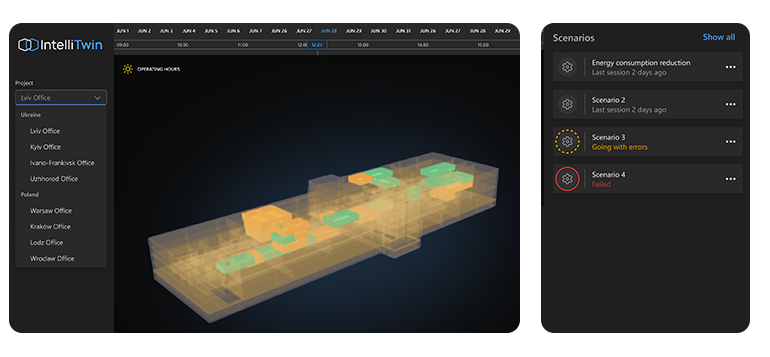
The platform was designed to seamlessly integrate with all types of modern IoT devices and is compatible with all modern connectivity standards (Bluetooth, cellular, Wi-Fi, etc.). In addition, you can integrate data from other software systems via APIs. Populate your twin with real-time, reliable data without any interoperability constraints.
All connected physical devices can also be managed remotely to optimize performance and safety. For example, you can automatically shut down an on-site heating system if a critical leak is detected or restrict access to certain areas to cleaning teams.
Scenario modeling
One of the biggest advantages of using digital twins is the ability to simulate different facility performance scenarios using real-world data.
Intellias Digital Twin features a low-code interface for running the following simulations:
- Energy usage efficiency
- Space utilization
- Occupancy rates
- Security and safety scenarios
- Environmental impact assessments
The Intellias Digital Twin platform also revolutionizes performance optimization with AI. A built-in algorithm prompts new simulation parameters and suggests parameter adaptation to achieve target improvements (for example, 10% energy savings). It leverages real-world data to achieve more efficient and sustainable operations.
The system also automatically scans for any data anomalies indicative of possible problems and can deliver predictive or prescriptive recommendations for better asset management. Examples of two common use cases include automatically configuring an HVAC system based on the time of day and recommending optimal staffing levels for each service area.
Our digital twin platform can be further customized to support more advanced scenarios for supply chain logistics, inventory management, building renovation or expansion projects, as well as an array of emergency response and disaster recovery scenarios.
Occupancy tracking
Using computer vision technology, Intellias Digital Twin can be used to track occupancy rates in every corner of a building. By knowing your occupancy patterns and indoor movement trends, you can optimize space layout, improve space reservation experiences, and prevent overcrowding in shared areas. For example, whenever there’s a large queue at the front desk, our digital facility management platform can automatically alert extra personnel to help manage the crowd.
Accurate people tracking also helps improve your employees’ safety and security. Our system is trained to detect abnormal human behavior (such as a person dropping to the floor) and automatically alert staff. When connected to smart security systems, Intellias Digital Twin can also alert staff about suspicious building entry attempts (such as an attempted turnstile entry with an expired staff badge).
Real-time occupancy data can also be used to inform cleaning protocols. For example, you can automatically schedule cleaning team dispatches or activate a robot vacuuming protocol in high-traffic areas. Or you can program event-based triggers for notifying janitorial services (for example, to initiate cleaning after a set number of meetings held in a conference room).
By accurately tracking occupancy levels, managers can dramatically improve tenants’ satisfaction while simultaneously optimizing labor and resource costs.
Outcomes: Smart facility management with digital twins
The cloud-native, scalable, and highly customizable Intellias Digital Twin platform was designed to support a wide range of facility types and operating scenarios. Our solution allows you to start generating cost savings almost immediately after deployment.
With Intellias Digital Twin, you get:
- Fast, streamlined digital twin deployment
- Real-time visibility into building operations
- Intuitive scenario modeling experience
- Ability to implement predictive maintenance
- AI-powered prescriptive recommendations
- High scalability and robust data security
- Recommendations for optimizing the environmental footprint
Final thoughts
Effective facility management equals effective data use. Digital twins provide real-time, high-fidelity, contextual insights on building performance trends, resulting in less energy waste, longer asset life, and higher tenant satisfaction. From digital twin tenant improvements to sustainable construction, the technology is paving its way forward in industries.
Intellias Digital Twin lowers the barrier to digital twin adoption. Built with interoperability at its core, our platform offers a clear-cut path to adopting data-driven facilities management practices. Reach out to our team for a free demo.
